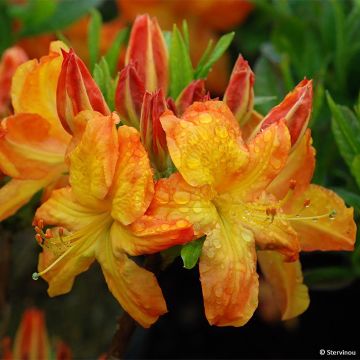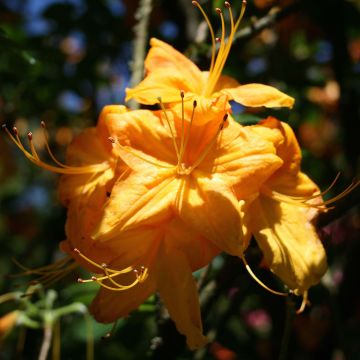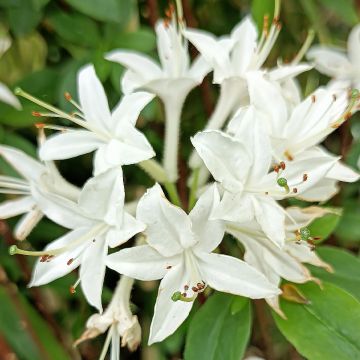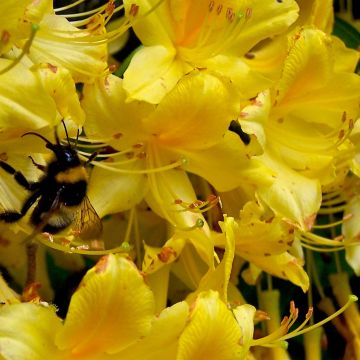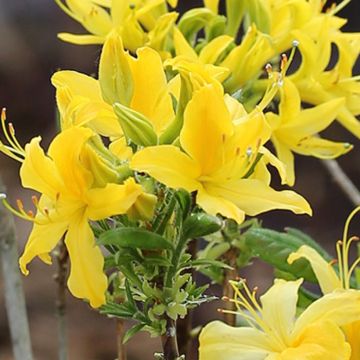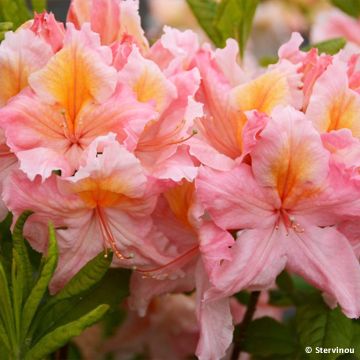

Chinese Azalea Satan
Chinese Azalea Satan
Rhododendron (Azalea) mollis Satan
Chinese Azalea, Soft Rhododendron
Special offer!
Receive a €20 voucher for any order over €90 (excluding delivery costs, credit notes, and plastic-free options)!
1- Add your favorite plants to your cart.
2- Once you have reached €90, confirm your order (you can even choose the delivery date!).
3- As soon as your order is shipped, you will receive an email containing your voucher code, valid for 3 months (90 days).
Your voucher is unique and can only be used once, for any order with a minimum value of €20, excluding delivery costs.
Can be combined with other current offers, non-divisible and non-refundable.
Why not try an alternative variety in stock?
View all →This plant carries a 24 months recovery warranty
More information
We guarantee the quality of our plants for a full growing cycle, and will replace at our expense any plant that fails to recover under normal climatic and planting conditions.
Would this plant suit my garden?
Set up your Plantfit profile →
Description
Rhododendron 'Satan' is a variety of Chinese azalea that stands out with large, decorative flowers in a very bright red with yellow stamens. They bloom in clusters in spring, enhanced by beautiful light green foliage. Unlike Japanese azaleas, this plant is deciduous and perfectly hardy. In addition to its brilliant flowering, the shrub also offers sumptuous autumn foliage. Too little known and used, Chinese azaleas are very graceful acid soil plants, and have many qualities, definitely worth discovering in the garden or in a large pot on the terrace!
The Rhododendron is a shrub in the heather family, the Ericaceae, native to central and eastern China, which has produced most of the cultivated deciduous azalea varieties in gardens through hybridization. 'Satan' is a hybrid cultivar from the Knap Hill series, known for its larger and more colourful flowers. It is a vigorous shrub that is both slender and bushy, with an upright habit, reaching about 1.30 m (4 ft 4 in) in height and 1.20 m (3 ft 11 in) in spread. Its flowering occurs from the end of May to June, abundantly and for a long period, at the same time as the young coppery leaves appear. The large flowers have a wavy trumpet shape, are well open in a star shape and are gathered in terminal clusters. They are a vibrant geranium red, each slightly marked with orange on the back of the petals, whose veins are a greenish-white. The deciduous foliage is composed of simple, ovate-lanceolate leaves with entire margins, arranged alternately on the branches. Their size varies from 5 to 10 centimetres (2 to 3.9 inches) in length, and their bright green colour in summer turns into orange and then into fairly dark red in October before falling. Rhododendrons have a shallow root system, which should never lack moisture, but they dislike stagnant humidity that suffocates them.
Chinese azaleas thrive in cool climates with distinct winters, planted in humus-rich and fertile soil, free of active limestone. They are very beautiful shrubs for flower beds, with a very natural habit, attractive twice a year. They happily accompany Japanese maples, which also change their appearance throughout the seasons, as well as Japanese camellias and their graceful cousins with often fragrant autumn flowering, the hybrids of C.sasanqua. They can also be grown in a carefully chosen large pot, in a suitable substrate, and preferably watered with non-chalky water. The extraordinary beauty of deciduous azaleas deserves some care to recreate the conditions they prefer.
Report an error about the product description
Chinese Azalea Satan in pictures


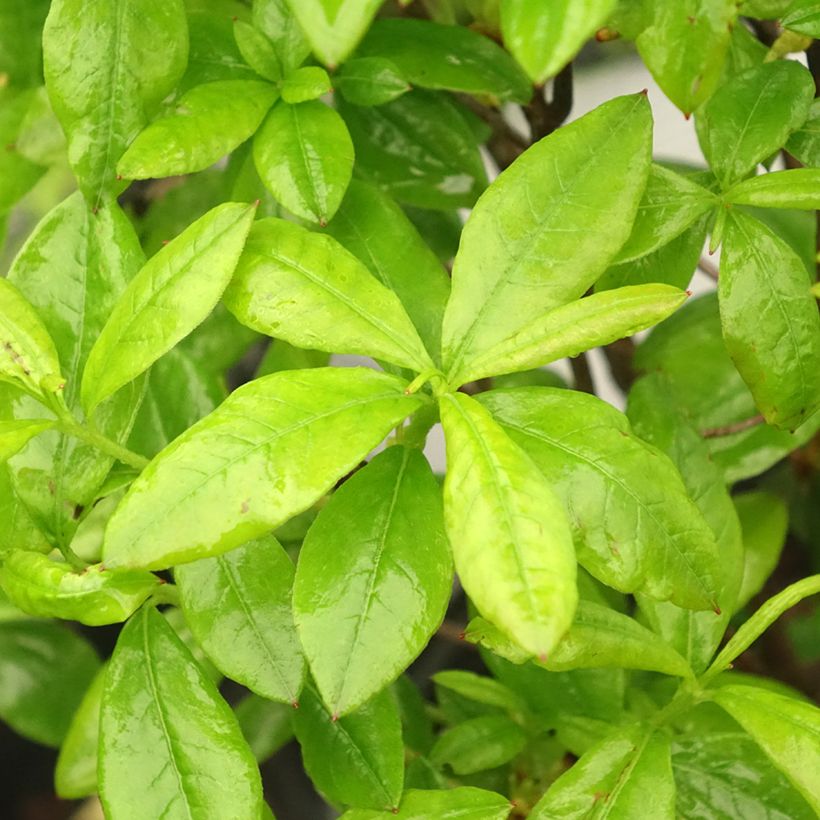

Plant habit
Flowering
Foliage
Botanical data
Rhododendron (Azalea)
mollis
Satan
Ericaceae
Chinese Azalea, Soft Rhododendron
Cultivar or hybrid
Other Chinese Azalea
View all →Planting and care
The Deciduous Azalea Satan enjoys a sunny location unlike the Japanese Azalea, but its preferred exposure is partial shade. Plant it in ericaceous soil or humus, moist but well-drained, definitely non-chalky. During planting, make sure not to bury the rootball too deep, it should be level with the ground. Water abundantly during dry periods, at least once a week for the first year. In spring, apply a fertilizer for acid-loving plants. After flowering you can prune lightly to maintain a tidy plant, but pruning is not essential. Remove faded flowers to encourage the emergence of new shoots. The Azalea has few diseases when well-established outdoors. It can be attacked by weevils that eat the edges of the leaves and the rootlets, as well as by the famous "rhododendron beetle" which does not often cause significant damage. If the soil is chalky or poorly drained, and if the plant is planted too deeply, the leaves may turn yellow.
Planting period
Intended location
Care
This item has not been reviewed yet - be the first to leave a review about it.
Haven't found what you were looking for?
Hardiness is the lowest winter temperature a plant can endure without suffering serious damage or even dying. However, hardiness is affected by location (a sheltered area, such as a patio), protection (winter cover) and soil type (hardiness is improved by well-drained soil).

Photo Sharing Terms & Conditions
In order to encourage gardeners to interact and share their experiences, Promesse de fleurs offers various media enabling content to be uploaded onto its Site - in particular via the ‘Photo sharing’ module.
The User agrees to refrain from:
- Posting any content that is illegal, prejudicial, insulting, racist, inciteful to hatred, revisionist, contrary to public decency, that infringes on privacy or on the privacy rights of third parties, in particular the publicity rights of persons and goods, intellectual property rights, or the right to privacy.
- Submitting content on behalf of a third party;
- Impersonate the identity of a third party and/or publish any personal information about a third party;
In general, the User undertakes to refrain from any unethical behaviour.
All Content (in particular text, comments, files, images, photos, videos, creative works, etc.), which may be subject to property or intellectual property rights, image or other private rights, shall remain the property of the User, subject to the limited rights granted by the terms of the licence granted by Promesse de fleurs as stated below. Users are at liberty to publish or not to publish such Content on the Site, notably via the ‘Photo Sharing’ facility, and accept that this Content shall be made public and freely accessible, notably on the Internet.
Users further acknowledge, undertake to have ,and guarantee that they hold all necessary rights and permissions to publish such material on the Site, in particular with regard to the legislation in force pertaining to any privacy, property, intellectual property, image, or contractual rights, or rights of any other nature. By publishing such Content on the Site, Users acknowledge accepting full liability as publishers of the Content within the meaning of the law, and grant Promesse de fleurs, free of charge, an inclusive, worldwide licence for the said Content for the entire duration of its publication, including all reproduction, representation, up/downloading, displaying, performing, transmission, and storage rights.
Users also grant permission for their name to be linked to the Content and accept that this link may not always be made available.
By engaging in posting material, Users consent to their Content becoming automatically accessible on the Internet, in particular on other sites and/or blogs and/or web pages of the Promesse de fleurs site, including in particular social pages and the Promesse de fleurs catalogue.
Users may secure the removal of entrusted content free of charge by issuing a simple request via our contact form.
The flowering period indicated on our website applies to countries and regions located in USDA zone 8 (France, the United Kingdom, Ireland, the Netherlands, etc.)
It will vary according to where you live:
- In zones 9 to 10 (Italy, Spain, Greece, etc.), flowering will occur about 2 to 4 weeks earlier.
- In zones 6 to 7 (Germany, Poland, Slovenia, and lower mountainous regions), flowering will be delayed by 2 to 3 weeks.
- In zone 5 (Central Europe, Scandinavia), blooming will be delayed by 3 to 5 weeks.
In temperate climates, pruning of spring-flowering shrubs (forsythia, spireas, etc.) should be done just after flowering.
Pruning of summer-flowering shrubs (Indian Lilac, Perovskia, etc.) can be done in winter or spring.
In cold regions as well as with frost-sensitive plants, avoid pruning too early when severe frosts may still occur.
The planting period indicated on our website applies to countries and regions located in USDA zone 8 (France, United Kingdom, Ireland, Netherlands).
It will vary according to where you live:
- In Mediterranean zones (Marseille, Madrid, Milan, etc.), autumn and winter are the best planting periods.
- In continental zones (Strasbourg, Munich, Vienna, etc.), delay planting by 2 to 3 weeks in spring and bring it forward by 2 to 4 weeks in autumn.
- In mountainous regions (the Alps, Pyrenees, Carpathians, etc.), it is best to plant in late spring (May-June) or late summer (August-September).
The harvesting period indicated on our website applies to countries and regions in USDA zone 8 (France, England, Ireland, the Netherlands).
In colder areas (Scandinavia, Poland, Austria...) fruit and vegetable harvests are likely to be delayed by 3-4 weeks.
In warmer areas (Italy, Spain, Greece, etc.), harvesting will probably take place earlier, depending on weather conditions.
The sowing periods indicated on our website apply to countries and regions within USDA Zone 8 (France, UK, Ireland, Netherlands).
In colder areas (Scandinavia, Poland, Austria...), delay any outdoor sowing by 3-4 weeks, or sow under glass.
In warmer climes (Italy, Spain, Greece, etc.), bring outdoor sowing forward by a few weeks.






























